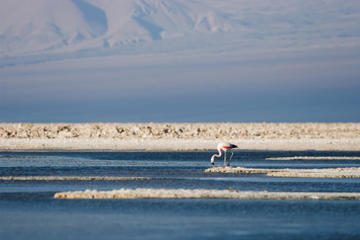
The world's driest desert is the Atacama, caught up at extreme altitudes within an Andean basin, shielded from the life-giving rain. There is water here, except for geyser fields and hot springs boiling up from the volcanic depths, rivers fed from snowy peaks above, and the lithium-rich Atacama Salt Lake.
The crackling salt surface of Salar de Atamaca, the world's second-largest salt flats, partially obscures the extent of this mineral-blue salt sea. Where the rich waters break through crystalline formations, flamingos and other seabirds match their plumage against the pink-and-purple painted hills.
There are several major lagoons, including Lagunas Miscanti, Chaxa, and most famously Cejar, a sinkhole boasting a salt concentration so high that "you can do yoga on the surface." While you can explore these harsh environs on your own, most visitors book multiple-day trips through the wilderness.
The closest town to the Atacama Salt Lake is San Pedro de Atacama, an old mining town that has only recently begun to serve as the area's premier tourist destination. Not only is it close to the Atacama Salt Lake, but it also serves as a great base for climbing area volcanoes such as symmetrical Volcán Licancabur, crowned with a crater lake, as well as visiting hot springs and other natural wonders.
The town itself is remarkable for its age, inhabited at least 10,000 years and considered Chile's most important archaeological treasure. The famous Gustavo El Paige Museum holds the most important treasures, but most tours through the region also take in ancient sites.
The small airport has regular flights to Santiago and elsewhere in the region, and buses connect the town to Calama, Antofagasta, San Salvador de Jujuy (Argentina), and Uyuni (Bolivia). Many multiple day tours offer transport between Uyuni as well. You can rent cars in town.